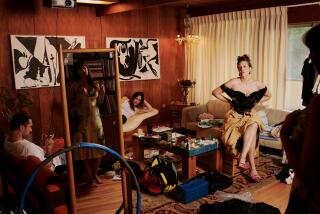Forever Plaid
- Share via
The Movie: “Rob Roy.”
The Setup: Early 18th-Century tale of Scottish hero of the people known as Rob Roy (Liam Neeson, pictured).
The Costume Designer: Sandy Powell, whose credits include “Interview With the Vampire,” “Orlando,” “The Crying Game,” “Caravaggio” and “Edward II.”
You Should Know: The Scottish man’s wardrobe staple is still a wonderful garment to behold. As Neeson demonstrates, the skirt (mid-knee was the typical length) was not only macho--particularly compared to the peacock-like breeches, tights, jackets and waistcoats worn by French and English noblemen--but also functional.
Before it evolved into its current cut during the Victorian Era, the kilt was one continuous bolt of fabric known as a plaid. Roy and his fellow Highlanders wrapped them around their waists, then tossed the excess over their shoulders, pinning it in place with a large brooch. If one were stranded in the wild, the plaid could be put into action as a blanket. As for Roy’s wife, Mary (Jessica Lange, pictured), her only bit of tartan is a faded shawl.
Historical Embellishment: Powell decided that, to modern eyes, men in kilts with bare legs “would have looked a bit daft,” so she put them in knee-high leather boots. Highlanders actually went barefoot while working the land; all the rain and mud would have made shoes pointless. When they did wear shoes, moccasins without socks were it.
Trivia: Roy and the Highlanders all wear muted tartans. Historically correct? No. The true colors would have incorporated the colors of the landscape, such as purple, pink, brown and green. “But I don’t think (director) Michael (Caton-Jones) was keen on that,” Powell said.
Indeed, the so-called feminine colors--pink, lilac and aqua--were reserved for the foppish and evil Cunningham (Tim Roth).
Inspiration: “Really, there’s very little on that period. It was very, very difficult to find any visual reference or descriptions for the Highlanders,” Powell said.
Sources: Tartans were woven on the isle of Islay in Scotland. Costumes were custom-made in London.
More to Read
Only good movies
Get the Indie Focus newsletter, Mark Olsen's weekly guide to the world of cinema.
You may occasionally receive promotional content from the Los Angeles Times.







